Number of families 86
Thumbnail description
Segmented worms with numerous bristles and one pair of parapodia per segment
Photo: Bristle or fire worms (Chloeia sp.) primarily come out at night and are scavangers.
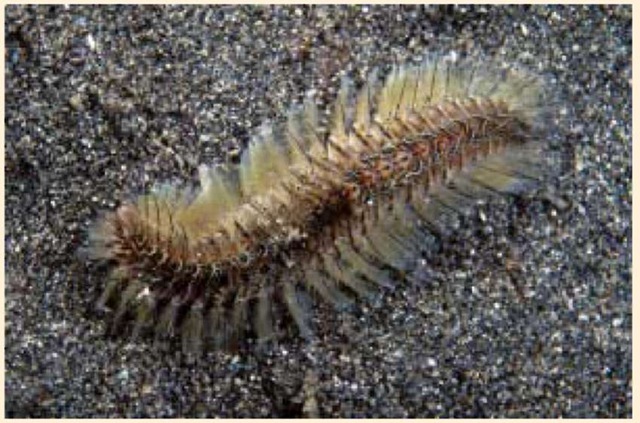
Evolution and systematics
Polychaetes do not fossilize very well as they are soft-bodied animals. There are few fossil records from an entire worm; these have been found from the Pennsylvanian fauna. The oldest fossil records, dating to the middle Cambrian of the Burgess Shale, include the aciculates Wiwaxia and Canadia, which have a prostomium with appendages, well-developed parapodia, and different kinds of chaetae.
A considerable diversification among polychaetes occurred in the Middle Cambrian, with six genera represented in Burgess Shale (Canada). The genera Wiwaxia and Canadia do not have jaws, but some later forms possess hard jaws that could mineralize with iron oxide. Such polychaete fossils are known as scolecodonts and have been described from the Ordovician, Silurian, and Devonian periods. Other poly-chaete fossils include tubes and burrow structures produced by some sedentary forms that secreted a mucous lining for their burrow.
Polychaeta and Clitellata, which includes the classes Oligo-chaeta and Hirudinoidea, are the two great lineages within the phylum Annelida. As the marine polychaetes fossils that appeared in Middle Cambrian are the earliest record of Annelida, they are considered to be the earliest derived group within the phylum. The exact nature of the ancestral group from which Polychaeta and Clitellata arose is still obscure, but it was likely a homonomous, metameric burrower that possessed a compartmentalized coelom, paired epidermal chaetae, and a head composed of a presegmental prostomium and a peris-tomium much like those found in modern polychaetes. Due to some recent molecular data and anatomical and developmental evidence, many scientists believe the pogonophorans and vestimentiferans should be placed within the Annelida as a specialized polychaete family, either Pogonophoridae or
Siboglionidae. The class Polychaeta is divided into 24 orders and 86 families, with more than 10,000 described species.
Physical characteristics
Polychaetes range in length from <0.078 in (<2 mm) to >9.8 ft (>3 m). The majority of them are <3.9 in (<10 cm) long and between 0.078-0.39 in (2-10 mm) wide. The morphology is greatly variable. The majority of polychaetes have a cylindrical and elongated body. The parapodia can be unir-ramous or biramous, with a dorsal lobe (notopodium) and ventral lobe (neuropodium).
The body morphology of polychaetes usually reflects their habits and habitats. Often, active forms have a more homo-nomous body construction than sedentary ones, which possess some degree of heteronomy, with differentiation in body regions that are utilized for particular functions.
Mobile forms usually have well-developed parapodia, eyes, and sensory organs. Additionally, in some species, the mouth has chitinous jaws and an eversible pharynx.
Sessile forms live in permanent burrows or tubes and have the parapodia reduced or absent; some of them possess special tentaclelike appendages projecting from the tube to collect food from the surface and also for aeration.
Polychaetes are extremely variable in color, varying from light tan to opaque, but most are colored red, pink, green, yellow, or a combination of colors. Some species are iridescent.
Polychaetes of the family Aphroditidae have the dorsum covered with scales (elytra) that can be overlaid by a hard hairlike layer. Because of these characteristics, one species is commonly called the “sea-mouse.” Some planktonic species are
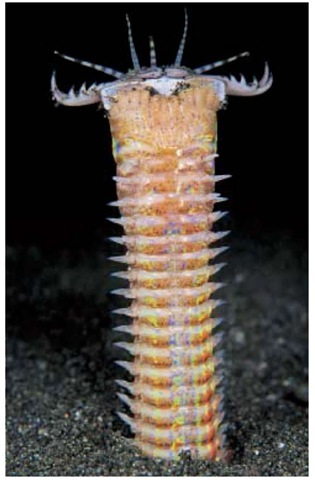
Eunice aphroditois is a predatory worm found in the Indo-Pacific. Not much research has been done on this particular species, though it was first described in the late 1700s. This and related worms are found all around the world in tropical and semitropical waters. It is a “sit and wait” predator, waiting in ambush for victims.
adapted to live in the water column by usually being transparent and flattened with fin parapodia.
It is very common to observe the gas exchange structures of some polychaetes, especially the colorful ones. The branchial morphology is greatly variable: filaments in cirrat-ulids, anterior gills in terebellids, and a tentacular or branchial crown on the heads of sabellids, serpulids, and spirorbids. The more active polychaetes possess a highly vascularized portion of the parapodia, utilizing it for gas exchange.
Distribution
Polychaetes are found worldwide, living in every marine habitat from tropical to polar regions. Some species occur in brackish or freshwater environments. A few live on land, but in habitats completely inundated with water.
Habitat
Due to morphological variations, polychaetes occupy different kinds of habitats, both planktonic and benthic. They are found from the intertidal zone to the deepest depths of the ocean in sandy and muddy sediments, digging or in temporary or permanent mucous tubes that are part of the in-faunal community, or crawling on the surface of the substrate. Some species live above the sediment surface as part of the epifaunal community; for example, some nereid species live between mussel beds attached to piers.
Polychaetes are also found in coral and rocky reefs, occupying crevices or beneath stones, and some construct sandy or calcareous tubes that are often attached to coral.
Planktonic forms have adapted structures to swim, and spend all their lives in the water column. Some species tolerate the low salinity of estuaries and a few live in freshwater environments. Some spionids and a group of nereids inhabit semi-terrestrial habitats where they can be covered by freshwater during the wet season and during tidal inundations.
There are some polychaetes that have been found in deep-sea thermal vents. Some species can be commensal or even parasitic. Histriobdella homari eats incrusted bacteria and blue-green algae found on the gills and branchial chamber of Homarus americanus and Homarus gammarus. One Stratiodrilus species feeds on microorganisms in the gill chamber of freshwater crayfish or anomuran crustaceans. In the family Oenon-idae, there are parasitic forms that live in the coelomic cavity of other polychaetes, echiurans, or bivalves.
Behavior
Polychaetes exhibit few behavior patterns. Certain species are gregarious, forming dense aggregations, while others are solitary. Horizontal and vertical partitioning of space in the sediment occurs between conspecifics and closely-related species or species from the same trophic group (species that feed on the same food resources).
Some polychaetes respond to shadows passing overhead and retreat rapidly back into their tubes. Some species “smell” their prey in the sediment through chemical sensory organs. Species that are prey of birds and fishes can discard their posterior end to avoid predation and can regenerate lost parts.
Some species pair during the breeding season; however, following this phase, they are so aggressive that they often eat each other. During spawning, several species are luminescent in response to light as a reproductive strategy. Others react to changes in temperature, day length, and Moon phases. All these responses are coordinated to ensure successful spawning and reproduction.
Feeding ecology and diet
The morphological and functional diversity of polychaetes enables them to exploit food resources in almost all marine environments in different ways. Polychaetes are usually categorized into raptorial (including carnivores, herbivores, and scavengers), omnivores, surface and subsurface deposit feeders, suspension feeders, and filter feeders.
Polychaetes can be non-selective or selective deposit feeders. The non-selective deposit feeders ingest sand or mud grains, showing little or no discrimination for the size and nutritional value of the particles, assimilating any organic material in the ingested sediment. Selective deposit feeders, however, utilize structures such as palps, tentacles, or buccal organs to select particles with high nutritional value.
The raptorial species usually have a homonomous construction, well-developed parapodia, sensory organs on the head, and a pharynx armed with hard jaws (nereids, glycerids, phyllodocids, syllids). They make rapid movements across the substratum. They often prey on small invertebrates. The prey can be located through sensorial or chemical means. Certain forms (glycerids) have poison glands associated with the jaws. Some raptorial species are not active hunters; they lie in wait for passing prey.
Herbivorous polychaetes feed by scraping or tearing plant material with their pharyngeal structures. Some scavengers feed on any dead or organic material they encounter. Omnivorous species feed on any material they find, and there are some carnivores that feed on deposits when prey are scarce.
Surface and subsurface deposit feeders ingest sandy or muddy particles, feeding on organic material attached to them. They usually have a saclike pharynx that sucks the grains from the sediment when burrowing (capitellids). Some surface deposit feeders have grooved mucous tentacles that collect particles from the surface and carry them directly into the mouth (terebellids, cirratulids).
Suspension feeders possess specialized structures such as tentacular sulcated crowns, or palps on the head, that enable them to collect suspended material in the water column. Some forms are very active, frequently moving their palps (spionids), and others simply expose their crown, waiting for particles to fall onto their surface (Oweniidae).
Filter feeders have specialized crowns with pinnated radi-oles that create a water current through the pinnules, collecting the particles in suspension (sabellids, sabelariids, spirorbids, serpulids).
Reproductive biology
Polychaetes have different degrees of regeneration. They regenerate lost appendages such as palps, tentacles, cirri, and parapodia. The regeneration of posterior ends is common, but regeneration of a lost head end is uncommon. Many polychaetes utilize regeneration during asexual reproduction, producing a series of individuals, a bud that grows from an individual, or new individuals that develop from an isolated fragment.
The majority of polychaetes are dioecious (gonochoristic); hermaphroditism occurs in relatively few species. Gametes usually mature inside the coelom and are released by gonod-ucts, coelomoducts, nephridia, or through the rupture of the parental body wall. The majority of species release their gametes into the water, where fertilization takes place. The larvae are planktotrophic, but some species have lecitotrophic larvae, and a few have both. Species with internal fertilization brood their eggs or produce encapsulated eggs that float or are attached to the substratum.
As a rule, segments are generated from a posterior growth zone, arising and developing sequentially from the anterior to the posterior.
Some polychaetes have evolved methods to increase the chances of fertilization. Some sexually reproductive nereids, syllids, and eunicids form an epitokous individual, wherein various body parts or the whole body become a gamete-carrying bag capable of swimming from the bottom upward into the water column, where the gametes are spread. In many poly-chaetes, the larva is a trochophore that possesses a locomotory ciliary band near the mouth region. The lifespan can range from a few weeks to several years, depending on the reproductive strategy of the particular species.
Conservation status
Polychaetes are part of many investigations that contribute to the conservation and knowledge of the biodiversity of the marine environment. No species of polychaete are listed by the IUCN. However, the Palolo worm, Eunice viridis, could potentially be in need of conservation efforts.
Significance to humans
Polychaetes play an important role in the marine benthic food chain, not only serving as food for other organisms, but also recycling organic matter within the sediment and breaking down plant material. Some polychaetes, such as nereids, are known to be important food sources for birds and for economically important fishes; polychaetes are also used as bait for recreational fishing.
Polychaetes play an important role in monitoring marine environmental quality. They respond quickly to changes in the environment, promoted by anthropogenic compounds or chemical contaminants because of their direct contact with the sediments and water column.
Some species can provide an indication of the condition and health of the sediment they live in and often occur at high densities in polluted habitats.
Some polydorids (Spionidae) bore into oyster shells, affecting their appearance and hence their market value, and cause a decline in oyster cultures or become pests. There are numerous significant fouling species that can settle and grow on the hulls of ships.
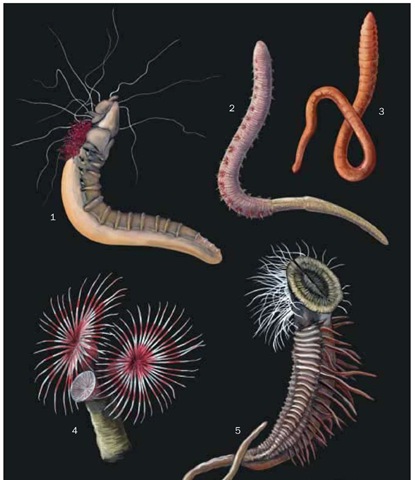
1. Sand mason (Lanice conchilega); 2. Lugworm (Arenicola marina); 3. Capitella capitata; 4. Tubeworm (Serpula vermicularis); 5. Honeycomb worm (Sabellaria alveolata).
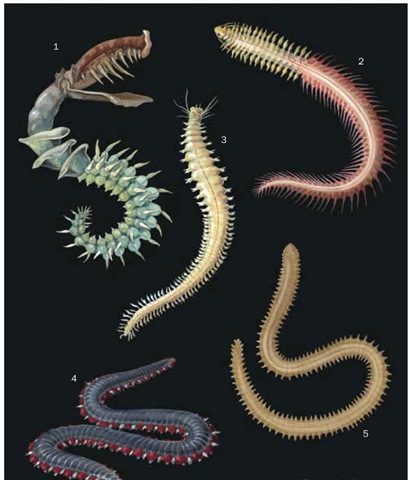
1. Parchment worm (Chaetopterus variopedatus); 2. Ragworm (Hediste diversicolor); 3. Pile-worm (Neanthes succinea); 4. Fire worm (Eurythoe complanata); 5. Catworm (Nephtys hombergii).
Species accounts
Fire worm
Eurythoe complanata
ORDER
Amphinomida
FAMILY
Amphinomidae
TAXONOMY
Eurythoe complanata (Pallas, 1766), Caribbean Sea.
OTHER COMMON NAMES
English: Bristleworm.
PHYSICAL CHARACTERISTICS
Body elongated and flattened dorso-ventraly, wide pros-tomium, one pair of eyes. They have three antennae, one pair of palps on the head, and dorsal branchial filament tufts that provide them with a blood-red color; the head bears a flattened keel caruncule (structure projecting from the posterior end of the prostomium that carries chemosensory organs called nuchal organs). The parapodia are well developed with different kinds of chaetae and possess calcareous, glassy, hollow harpoon chaetae with neurotoxins that cause discomfort when they contact human skin, thus the reason for common name of “fire worm.”
DISTRIBUTION
All tropical seas.
HABITAT
Inhabit cryptic intertidal and shallow subtidal areas, living in crevices, under and between rocks, or in dead coral substrata. Also found in sand and mud.
BEHAVIOR
Found intertidal areas under rocks, forming nests. Assumes a defensive posture, arching its body dorsally to display expansive fascicle of harpoon chaetae when disturbed. Active during the night and usually hidden during daytime.
FEEDING ECOLOGY AND DIET
Omnivorous and a scavenger. Ventral pharynx is eversible, unarmed, strongly muscular, and bears tranverse ridges. When feeding, it positions itself above the prey or food and uses mouth apparatus to rasp and squeeze food material into the mouth. After swallowing the food, the ridges carry it to the digestive tract. It can find prey by contact and also by chemosensory mechanisms.
REPRODUCTIVE BIOLOGY
Exhibits both asexual and sexual reproduction. Asexual reproduction occurs when individuals undergo fragmentation, dividing the body into one or more parts that regenerate to form heads, tails, or both, and grow into new individuals.
CONSERVATION STATUS
Not listed by the IUCN.
SIGNIFICANCE TO HUMANS
If individuals are handled, the bristly, calcareous harpoon chaetae breaks off and remains in contact with the skin. These
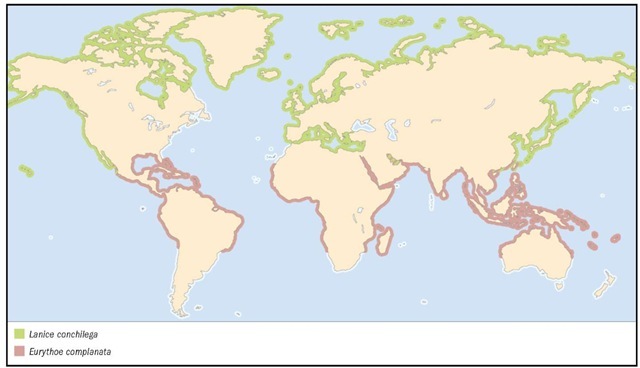
chaetae release an acidic neurotoxin, causing reactions such as inflammation and swelling.
Lugworm
Arenicola marina
ORDER
Capitellida
FAMILY
Arenicolidae
TAXONOMY
Arenicola marina Linnaeus, 1758, Sweden.
OTHER COMMON NAMES
English: Blow lug, bristleworm.
PHYSICAL CHARACTERISTICS
Has cylindrical and firm body divided into two regions: thorax and abdomen. The head is small and has no appendages or eyes. Has a rough proboscis that is usually visible. The thoracic region possesses 19 parapodia with chaetae, some of them bearing arborescent gills. Abdominal region is narrow and lacks chaetae and gills. Body segments are divided into five rings (annuli). Reaches between 4.7-7.8 in (120-200 mm) in length and varies in color from pink to dark pink, red, green, dark brown, or black.
DISTRIBUTION
Recorded from shores of western Europe, Norway, Spitzbergen, north Siberia, and Iceland. In the western Atlantic, it has been recorded from Greenland, along the northern coast from the Bay of Fundy to Long Island. Its southern limit is about 40°N.
HABITAT
Occurs all over intertidal region in sand and muddy sand, inhabiting a characteristic U- or J-shaped tube it forms by burrowing through the sediment.
BEHAVIOR
Digs U- or J-shaped burrow ranging from 7.8-15.7 in (20-40 cm) deep that has a depression at the head end and small amount of defecated material at the tail end; this defecated material has the color of clean sand. Feeding, defecation, and burrow irrigation behavior is cyclic and can last from 15-42 minutes, depending on the size of the animal. The burrow is irrigated and consequently aerated by intermittent cycles of peristaltic contractions of the body from the tail to the head end. Therefore, concentrated oxygenated water is taken in at the tail end and leaves by percolation through the feeding column.
FEEDING ECOLOGY AND DIET
Feeds on surface sedimentary material with the head end of its burrow, forming a feeding column and characteristic funnel or “blow hole” to the surface sediment. Sucks particles with the aid of the saclike proboscis. Small, ingested particles are attached to the proboscis papillae and the larger are rejected and accumulate around the burrow opening. Microorganisms such as bacteria, benthic diatoms, meiofauna, and detritus attached to particles are digested in the gut.
REPRODUCTIVE BIOLOGY
Gonochoristic, oviparous, with a lifespan from 5-10 years. The eggs and early larvae develop in the female burrow, but post larvae are capable of migration. Spawning takes place within the burrow and the release of gametes occurs by rhythmic contractions of the body wall. Gametes are released through the nephridia. Sperm is flushed out of the burrow by pumping activity of the male, while oocytes are retained in the horizontal shaft of the female’s burrow.

CONSERVATION STATUS
Not listed by the IUCN.
SIGNIFICANCE TO HUMANS
Utilized commercially as bait. Reworking of the sediment (bio-turbation) by this and other species affects the cycling and retention of contaminants such as hydrocarbons and heavy metals within the sediment. It is presently used routinely as a standard bioassay organism for assessing the toxicity of marine sediments.
No common name
Capitella capitata
ORDER
Capitellida
FAMILY
Capitellidae
TAXONOMY
Capitella capitata (Fabricius, 1870), Greenland.
OTHER COMMON NAMES
English: Bristleworm.
PHYSICAL CHARACTERISTICS
Body flexible, slender, elongated and blood red in color, earthwormlike appearance, 0.78-3.9 in (2-10 cm) long. The head is conical and shovel shaped. The parapodia are reduced with chaetae in both rami. Single genital pore between chaetigers eight and nine; in males this pore is surrounded by cross spines.
DISTRIBUTION
Found worldwide.
HABITAT
Inhabits muddy sand, gritty sand, fine sand, or mud on lower intertidal to sub-littoral habitats. Also found under pebbles or small stones, with burrows at or near the surface of the sediment. Occurs in high abundance, associated with organically enriched substrates.
BEHAVIOR
Burrower; often a solitary non-migratory species, living in high numbers in areas of organic enrichment where sewage inputs and fish farms are present. It is also found in sediments with high concentrations of metals and hydrocarbons.
FEEDING ECOLOGY AND DIET
Non-selective subsurface deposit feeder, feeding on microorganisms, phytoplankton, and detritus. Everts a saclike pharynx and aglutinates sand grains in order to feed.
REPRODUCTIVE BIOLOGY
Spawns once or twice a year, and in natural populations, sexual maturity is reached at about four months. Female produces from 100-1,000 eggs. Considered to be iteroparous, and the lecithotrophic larvae are brooded during part of their development within the adult tube. Potential longevity ranges from 45 days to two years.
CONSERVATION STATUS
Not listed by the IUCN.
SIGNIFICANCE TO HUMANS
Provides an important food source for the shrimp Crangon crangon. Has been accepted as pollution indicator. ♦
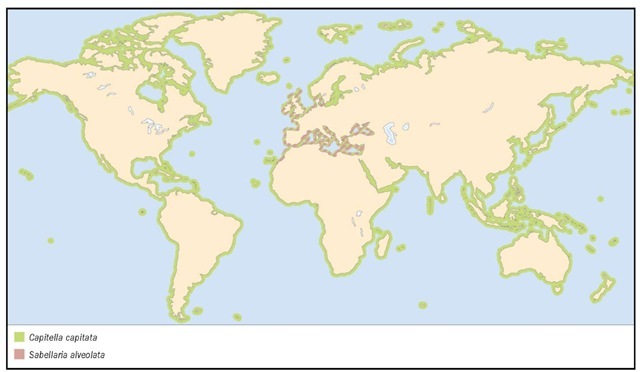
Catworm
Nephtys hombergii
ORDER
Phyllodocida
FAMILY
Nephtyidae
TAXONOMY
Nephtys hombergii Savigny, 1818, coast of France.
OTHER COMMON NAMES
English: Bristleworm.
PHYSICAL CHARACTERISTICS
Thin worm reaching 3.9-7.8 in (10-20 cm) in length. Body rectangular in cross section and pearly iridescent white in color; head bears four small eyes and a papillated proboscis. Parapodia are well developed with golden bristles.
DISTRIBUTION
Found from the northern Atlantic, from such areas as the Barents Sea, the Baltic, and the North Sea, to the Mediterranean. Has been reported as far south as South Africa.
HABITAT
Common in lower intertidal zone, frequently found in high density in muddy substrata.
BEHAVIOR
During feeding activity, this solitary species burrows 1.9-.9 in (5-15 cm) beneath the sediment. Also swims with undulating movements of the body, but only short distances.
FEEDING ECOLOGY AND DIET
Scavenger or active carnivore, feeding on small invertebrates. Papillated proboscis is employed when capturing prey.
REPRODUCTIVE BIOLOGY
Gonochoristic. Mature individuals stimulated to spawn and release sperm and eggs on the sediment surface during low tide. Larvae are lecithotrophic at first stage and, after that, plank-totrophic. Life cycle lasts 2-5 years, with individuals reaching maturity in two years.
CONSERVATION STATUS
Not listed by the IUCN.
SIGNIFICANCE TO HUMANS
Used as bait by fishermen and considered an important food source for birds. Its predation activity can decrease the biomass of prey in its habitat.
Ragworm
Hediste diversicolor
ORDER
Phyllodocida
FAMILY
Nereididae
TAXONOMY
Nereis diversicolor (Miiller, 1775), Baltic Sea.
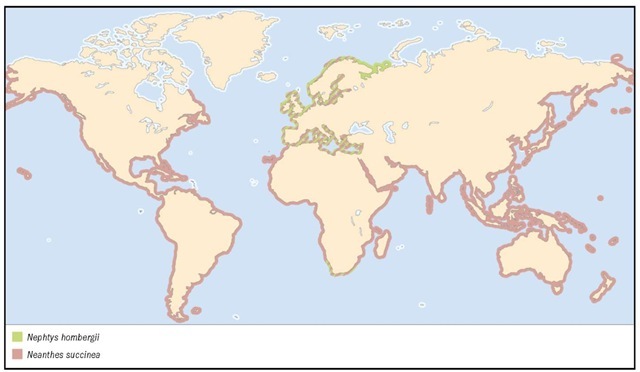
OTHER COMMON NAMES
English: Bristleworm, clamworm.
PHYSICAL CHARACTERISTICS
Body elongated and flattened with conspicuous parapodia with bristles. The head has four eyes, two antennae, and two palps. Has eversible pharynx; armed with chitinous teeth. Color is greenish during spawning season and varies from red to light brown at other times.
DISTRIBUTION
Widely distributed throughout northwest Europe in the Baltic Sea, North Sea, and along Atlantic coast to the Mediterranean.
HABITAT
Euryhaline. Found in sandy and muddy sheltered environments in intertidal region.
BEHAVIOR
Solitary organism that builds conspicuous burrow that serves as a site for foraging and as refuge against predation by birds.
FEEDING ECOLOGY AND DIET
Has great variety of feeding modes: passive suspension feeder; surface and subsurface deposit feeder; active and passive omni-vore; and scavenger preying on small invertebrates, plant material, or ingesting sand and mud particles to utilize the attached detritus. Utilizes eversible pharynx to capture prey.
REPRODUCTIVE BIOLOGY
Gonochoristic, oviparous, reproducing once in entire life. Larva is lecithotrophic. Maturation and spawning influenced by temperature in spring, and during this phase, males are brighter green and females are darker green. Reproductive pheromones coordinate processes such as mate location and synchronism for release of gametes when males discharge sperm around burrow of females. Adults reach maturity in one to three years.
CONSERVATION STATUS
Not listed by the IUCN.
SIGNIFICANCE TO HUMANS
Important food source for different species of wading birds and serves as bait for fishermen. ♦
Pile-worm
Neanthes succinea
ORDER
Phyllodocida
FAMILY
Nereidae
TAXONOMY
Nereis succinea (Neanthes) Frey and Leuckart, 1847, North Sea.
OTHER COMMON NAMES
English: Bristleworm.
PHYSICAL CHARACTERISTICS
Body is usually red in color, reaching up to 7.4 in (19 cm). Head with four large eyes, small antennae, and long palps. Pharynx bears chitinous jaws and small teeth (paragnaths). Parapodia are well developed with bristles.
DISTRIBUTION
Cosmopolitan in temperate and tropical waters.
HABITAT
Found from intertidal zone to subtidal regions in mud and sand and under rocks as infaunal organism, as well as in dock-fouling communities of marinas, hiding between mussel and oyster beds as part of the epifauna. Being an euryhaline species, it is also found in estuarine regions.
BEHAVIOR
Active crawler at night; hidden during daytime when it constructs a mucous-lined tube.
FEEDING ECOLOGY AND DIET
The jawed eversible proboscis is used to capture small invertebrates or graze on detritus and plant material. Usually feeds at night.
REPRODUCTIVE BIOLOGY
Sexes are separated. During breeding season, it becomes epitokous (modified forms filled with gametes called het-eronereids) and individuals swim together stimulated by pheromones, releasing gametes in water where fertilization takes place.
CONSERVATION STATUS
Not listed by the IUCN.
SIGNIFICANCE TO HUMANS
Larva is preyed upon by fishes and birds that feed in water column.
Tubeworm
Serpula vermicularis
ORDER
Sabellida
FAMILY
Serpulidae
TAXONOMY
Serpula vermicularis Linnaeus, 1767, western Europe.
OTHER COMMON NAMES
English: Bristleworm.
PHYSICAL CHARACTERISTICS
Permanent tube-dwelling polychaete; body length from 1.9-2.7 in (5-7 cm) with up to 200 segments. Head possesses two opposing circles of bipinnate radioles, forming a spiral crown when extended outside of its tube, and a calcareous operculum that is funnel-shaped and pinkish white in color. Tube is cylindrical with some irregular ridges and is made of calcium carbonate. Body can be pale yellow to red in color.
DISTRIBUTION
Northeast Atlantic and Mediterranean Sea.
HABITAT
Constructs calcareous tubes on hard substrata such as rocks, stones, and bivalve shells. Found from sublittoral fringe to cir-calittoral up to 820 ft (250 m) depth. In some very sheltered areas, the tubes aggregate together to form small reefs.
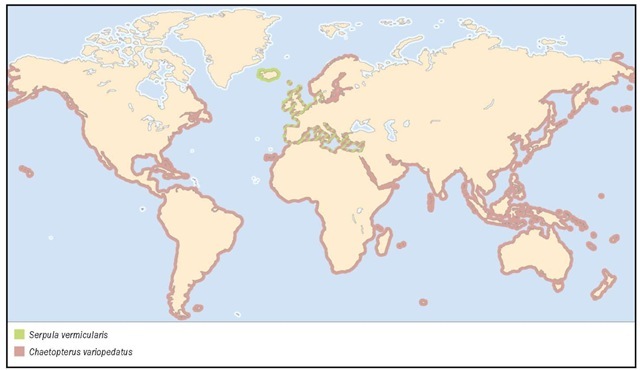
BEHAVIOR
Tubes are permanently attached to the substrate. Can be gregarious if there are few substrates for larvae to settle on, but in open marine habitat, it is usually solitary.
FEEDING ECOLOGY AND DIET
Active suspension feeder, exposing its bipinnated crown out of its tube to feed. The pinnules of the radioles create water current into crown, which collects suspended material from the water column.
REPRODUCTIVE BIOLOGY
Gonochoristic; reproduces annually. Larva is planktotrophic and reaches maturity within one year. Lifecycle 2-5 years; spawning occurs in summer.
CONSERVATION STATUS
Not listed by the IUCN, but included in U.K. Biodiversity Action Plan.
SIGNIFICANCE TO HUMANS
Permanent tubes constructed by this species create microhabi-tats for other species, increasing local biodiversity. ♦
Parchment worm
Chaetopterus variopedatus
ORDER
Spionida
FAMILY
Chaetopteridae
TAXONOMY
Chaetopterus variopedatus (Renier, 1804), Mediterranean Sea.
OTHER COMMON NAMES
English: Bristleworm.
PHYSICAL CHARACTERISTICS
Body is irregularly segmented and divided into three regions with a dorsal ciliated groove running along its length and can be up to 9.8 in (25 cm) long; yellowish or greenish white in color. Anterior and first region is flattened on the ventral side and bears glands that secrete the tube. There are modified chaetae at the fourth chaetiger that are used to cut the tube wall. The second region of the body has winglike, modified notopodial lobes that secrete the mucus where the suspended particles are trapped. The third region is longer and distinctly segmented. Some parts of the body are phosphorescent.
DISTRIBUTION
Cosmopolitan in both tropical and temperate seas.
HABITAT
Found from intertidal to shelf depths in soft sediments such as sand and mud; can be found with their tubes attached to pier or any hard substratum. Their vacant tubes can be occupied by other species of polychaetes, and they share the tube with two crabs species from the genera Pinnixia and Porcellana; however, they do not occur in the same tube.
BEHAVIOR
Constructs a tough and flexible U-shaped tube in soft substrata with only the ends of the tube protruding from the surface. The tube has the consistency of paper and can be covered with sand, mud, or shell fragments.
FEEDING ECOLOGY AND DIET
It is a filter-feeding worm, dining on suspended organic material. Sea water is pumped through the tube by winglike notopodia, which secrete mucus that is drawn back, forming a bag.
The mucous bag filters the water to retain finer particles. Periodically, it is transported back to the mouth by the dorsal ciliated groove and ingested.
REPRODUCTIVE BIOLOGY
Gonochoristic; breeding all year round. Larva is long-lived and planktotrophic. The segments destined for the mid-body region develop precociously and more rapidly than anterior segments. This accelerated development (also called heterochrony) is not seen in other polychaetes.
CONSERVATION STATUS
Not listed by the IUCN.
SIGNIFICANCE TO HUMANS
Has long been used in developmental biology experiments because it is easy to maintain in laboratory settings and provides larvae and embryos in vitro.
Sand mason
Lanice conchilega
ORDER
Terebellida
FAMILY
Amphitritinae
TAXONOMY
Lanice conchilega Pallas, 1766, Holland.
OTHER COMMON NAMES
English: Bristleworm.
PHYSICAL CHARACTERISTICS
Body up to 11.8 in (30 cm) long; yellow, pink, and brownish in color. Possesses 17 segments in front region with three pairs of blood-red colored arborescent gills and a white tentacular crown.
DISTRIBUTION
From the Arctic to the Mediterranean Sea, in the Arabian Gulf and the Pacific Ocean.
HABITAT
Found from intertidal zone down to 5,577 ft (1,700 m) in coarse, fine, clean sand, and mud.
BEHAVIOR
Can be found as solitary individual or in dense populations. Constructs tube from sand grains and shell fragments that have a frayed end protruding above the sand.
FEEDING ECOLOGY AND DIET
Active suspension feeder or surface deposit feeder, depending on local density; at low density, it is a deposit feeder, and at high density, it is suspension feeder to avoid competition with neighboring worms.
REPRODUCTIVE BIOLOGY
Gonochoristic; gametes occur from April to October in Northern Hemisphere. Larva is planktrotrophic; survives up to 60 days in the plankton, so dispersal distance may be great.
CONSERVATION STATUS
Not listed by the IUCN.
SIGNIFICANCE TO HUMANS
The tube constructed by this species increases the stability of sediment and consequently the stability of other species. Also, a mollusk species (Acteon tornatilis) and some birds eat this worm.
Honeycomb worm
Sabellaria alveolata
ORDER
Terebellida
FAMILY
Sabelariidae
TAXONOMY
Sabellaria alveolata Linnaeus, 1767, England.
OTHER COMMON NAMES
English: Bristleworm.
PHYSICAL CHARACTERISTICS
Colonial segmented worm that builds tubes from cemented coarse sand and/or shell material, forming reefs. Adult size ranges from 1.1-1.5 in (30-40 mm). Thorax has three pairs of flattened chaetal sheaths; has chaetes that form an operculum utilized to close the tube opening. The color of the tube varies, depending on the color of the sand locally available for tube construction.
DISTRIBUTION
Mediterranean Sea, north Atlantic to south Morocco. Also found in the British Isles to its northern limit in the northeast Atlantic.
HABITAT
Open coasts, usually intertidal and occasionally subtidal. Settlement occurs on hard substrata, but species needs adequate sand and shell fragments to build up its tube.
BEHAVIOR
Permanently attached to the substratum and is gregarious. Adapted to close its operculum during low tide to avoid desiccation and predation. The tube can reach 7.8 in (20 cm) in length and around 0.19 in (5 mm) in diameter at the external opening.
FEEDING ECOLOGY AND DIET
Passive suspension feeder, ingesting seston during high tide.
REPRODUCTIVE BIOLOGY
Gonochoristic; reproductive frequency is annual. Female produces from 100,000-1,000,000 eggs. The larva is planktotrophic and has dispersal potential of more than 6.2 mi (10 km). The lifecycle ranges from 2-5 years; adults reach maturity within the first year.
CONSERVATION STATUS
Not listed by the IUCN, but included in U.K. Biodiversity Action Plan.
SIGNIFICANCE TO HUMANS
Provides substratum to other marine invertebrates to settle on, increasing the spatial heterogeneity and consequently local diversity. Fishermen collect them from reefs for use as bait.
